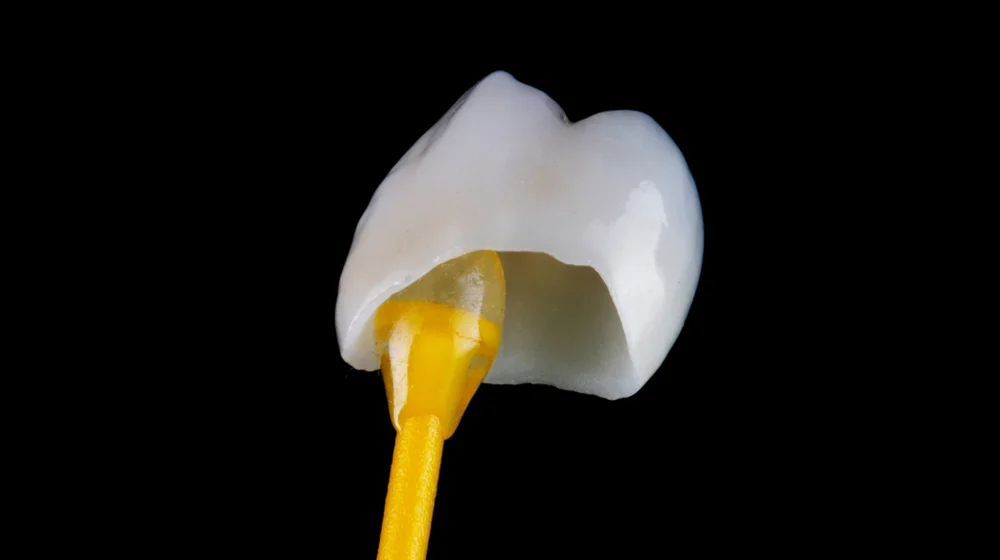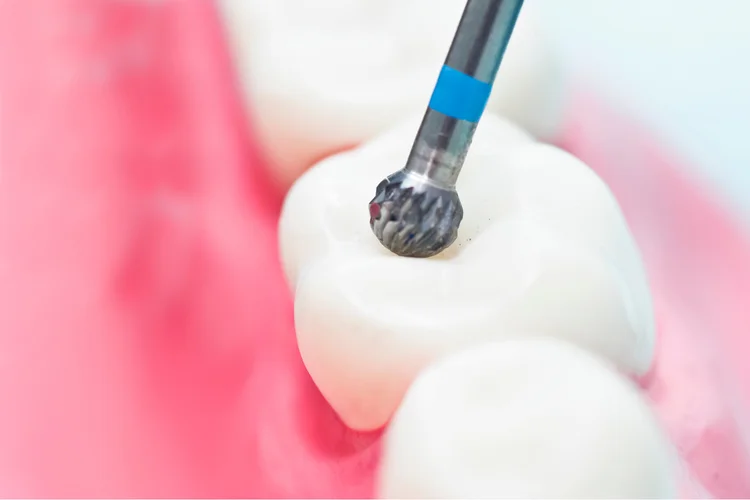If you are interested in restoring a bright and confident smile, two common options to consider are dental veneers and crowns. Both treatments can improve damaged, discolored, or worn teeth, but they differ in coverage, function, preparation, preservation, cost, and durability. While veneers mainly enhance appearance by providing a smooth, polished look, crowns offer both aesthetic improvements and support for weakened teeth. Join us as we explain the main differences between veneers and crowns, helping you choose the best option for a smile that is both attractive and functional.

What’s the Difference Between Crowns and Veneers?
Veneers are thin, custom-made shells, usually crafted from porcelain or composite resin, that cover only the front surface of a tooth. They are primarily cosmetic, designed to enhance appearance by masking imperfections like stains, minor chips, or slight misalignments. Veneers offer a natural look due to their translucent quality and are highly popular for creating a bright, flawless smile.

Crowns, or caps, fully encase a damaged tooth, restoring both its appearance and functionality. Crowns are generally made of porcelain, ceramic, zirconia, gold, or metal, and are designed to withstand biting forces, making them ideal for teeth requiring significant restoration. Unlike veneers, crowns provide additional support to the underlying tooth.

Crowns vs. Veneers: Pros and Cons
Here’s a quick breakdown of the pros and cons between veneers and crowns:
| Features | Veneers | Crowns |
|---|---|---|
| Tooth Coverage & Functionality |
Covers
front teeth only Primarily for cosmetic use |
Full-tooth coverage Restores bite and function |
| Tooth Preparation & Preservation |
Moderate
enamel removal Requires replacement if damaged to maintain aesthetics |
Significant enamel removal May impact natural tooth structure |
| Cost | Generally less costly | Typically cost more |
| Durability & Lifespan |
Durable
but thinner Lasts 5-15 years depending on veneer type More vulnerable to grinding and hard food damage |
Highly
durable Similar lifespan More resistant to wear from grinding and hard foods |
Tooth Coverage and Functionality
Veneers are designed as cosmetic covers on the front of teeth, concealing imperfections without adding structural reinforcement. Crowns, on the other hand, fully encase the tooth, providing protection and support for natural function. This is especially beneficial for weakened or heavily worn teeth, such as those with fractures or large cavities, as they help restore a normal bite and chewing ability. Crowns are therefore ideal for individuals looking for both aesthetic enhancement and functional improvements.
Tooth Preparation and Preservation
Veneers typically require only a small amount of preparation, involving just a slight removal of the front enamel of the tooth to ensure a precise fit. This approach helps preserve more of the tooth’s natural structure. In contrast, crowns involve more extensive reshaping, as the tooth must be reduced in size to securely fit the full-coverage cap. Removing natural tooth material can affect the long-term strength of the tooth and may lead to issues such as sensitivity, decay underneath the crown, or even fractures if not properly maintained. While crowns are suitable for significant restorations, they may be less appropriate for individuals who wish to preserve as much of their natural tooth as possible.

Cost Differences
The cost of veneers and crowns varies based on the material, the number of restorations, and the complexity of the procedure, among other factors. Crowns tend to be more expensive due to their full-tooth coverage and added functionality, often requiring more intricate fitting and crafting. This higher cost makes crowns an ideal investment for those with extensive restorative needs. Veneers, generally being less costly, are ideal for patients focused on aesthetic improvements without significant structural restoration.
Durability & Lifespan
Both veneers and crowns are durable options built to last for many years.
Composite veneers generally have a lifespan of 5-7 years, while porcelain
veneers can last 10-15 years and are more resistant to staining, chipping,
and wear. However, habits like teeth grinding or
biting hard foods should be avoided to prevent damage which reduces their
lifespan. Crowns are crafted to withstand significant wear and tear.
Constructed from strong materials, they are generally more resistant to
grinding and hard foods, making them a preferable choice for individuals who
may have habits that increase tooth wear.
Regardless of your choice between veneers and crowns, maintaining oral
hygiene through daily care and routine dental check-ups can help preserve
their appearance and condition for years to come.
Summary: Choosing the Right Option for You
Deciding between veneers and crowns ultimately depends on your unique dental needs and personal goals for your smile. Veneers are ideal if you’re looking solely for a cosmetic enhancement, providing a refined, polished look. Crowns, on the other hand, are more suited for restoring both aesthetics and functionality, particularly when teeth need reinforcement. If you’re unsure which option suits you best, consult with our friendly dentists who can guide you in choosing the right treatment to revitalise your smile!
How Do I Book a Dental Veneers Appointment?
Book Dental Veneers Appointment
Book NowEnquire More Through Email
Email Us NowEnquire More Through WhatsApp
WhatsApp Us NowWhy Choose True Dental Studio?
Friendly Dentist and Team
Our team treats each and every patient to the best of our ability. This is the reason why entire families have continued their dental care with True Dental Studio for many years, from all over Singapore.
Minimal Discomfort
At True Dental, it is our commitment to ensure our patients are kept as comfortable as possible. We aim to minimize discomfort, if any, for our patients.
Affordable Treatments
We believe in pricing quality treatments at a competitive rate. We are transparent and upfront with our treatment costs.
Our Smile Scorecard
Frequently Asked Questions
It depends on your needs. Veneers are ideal for cosmetic fixes like discoloration or slight misalignment. Crowns, however, are better suited for structural restoration, as they repair damaged or weakened teeth while also enhancing aesthetics, making them a versatile choice for both function and appearance.
Crowns generally last longer, about 10-15 years or more, while porcelain veneers last 10-15 years and composite veneers around 5-7 years. Whichever option you choose, maintaining good oral hygiene through daily brushing, flossing, and regular dental check-ups is essential to preserving their appearance and prolonging their lifespan.
Many people choose veneers for cosmetic enhancement, as they create a bright, uniform smile. Crowns are often preferred for structural support and are commonly used for teeth with more significant damage, such as fractures or decay, while still providing an aesthetic boost.
Veneers are designed to provide a natural aesthetic, particularly for front teeth, as they are custom-made to mimic natural enamel and cover only the visible surface. Crowns can also look very natural, especially when crafted from porcelain or ceramic, and blend seamlessly with surrounding teeth.
Crowns require substantial reshaping of the natural tooth and this reduction can lead to issues like sensitivity and a higher risk of decay underneath with poor oral hygiene and care. However, they offer both functional and aesthetic benefits, making them an ideal solution for severely damaged teeth despite these potential drawbacks.
The best choice depends on your dental needs and smile goals. For minimal enhancements, teeth whitening or bonding may be ideal, while crowns provide a restorative solution for damaged teeth. Veneers, however, remain a top choice for significant cosmetic improvements, delivering a natural look, durability, and customisation for a perfect fit.
High-quality crowns on front teeth are typically designed to look natural and blend seamlessly with adjacent teeth. However, older or poorly matched crowns may appear more noticeable. Veneers are often the preferred choice for front teeth as they offer a highly natural look with less tooth alteration, especially for purely aesthetic enhancements.
No, veneers are not applied over crowns, as crowns fully cover the tooth, making veneers unnecessary. If a crown needs updating or aesthetic improvement, it would typically be replaced with a new crown instead.
Veneers are designed to mimic natural teeth, making them nearly undetectable. Crafted to match the colour, translucency, and texture of real enamel, veneers blend seamlessly with surrounding teeth, providing a flawless, natural look that’s hard to spot.
Crowns are selected over veneers when a tooth requires significant restoration or structural support due to issues like extensive decay, fractures, or wear. Unlike veneers, crowns fully encase the tooth, restoring both aesthetics and functionality while providing lasting protection against further damage.
Yes, veneers are thinner than crowns, covering only the front surface of the tooth. Crowns are thicker, as they fully cover the tooth for added protection.
No, veneers aren’t applied over crowns since crowns already cover the entire tooth, making veneers unnecessary. If your crown needs an update for aesthetics or function, it would typically be replaced with a new crown.
For purely cosmetic enhancements, veneers are typically preferred for front teeth. Crowns are better if the front teeth are damaged or need added support.
Yes, you can get Invisalign with crowns and veneers. However, your dentist will need to evaluate the condition and positioning of existing crowns and veneers to ensure compatibility.
